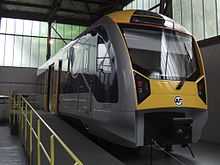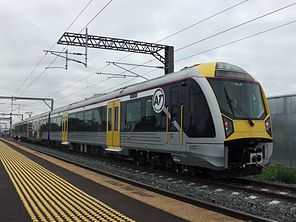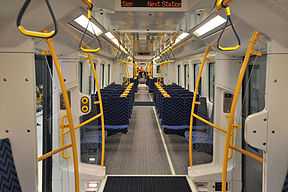New Zealand AM class electric multiple unit
| New Zealand AM class electric multiple unit | |
|---|---|
|
AM 103 at Puhinui station | |
|
Interior | |
| In service | 2014 |
| Manufacturer | CAF |
| Built at | Beasain, Spain |
| Family name | CxK |
| Replaced |
ADK, ADL class DMUs SA, SX class locomotive hauled carriages |
| Constructed | 2013 - current |
| Entered service | 2014 - current |
| Number under construction | 6 |
| Number built | 51 |
| Number in service | 34 |
| Formation | 1 AMA (motor) + 1 AMT (trailer) + 1 AMP (motor/pantograph), per set[1] |
| Capacity | 230 seated, 143 standing, 373 total[2] |
| Operator | Transdev Auckland |
| Depot(s) | Wiri |
| Line(s) served |
Eastern Line Onehunga Line Southern Line (limited) Western Line (future) |
| Specifications | |
| Car body construction | Stainless steel[2] |
| Train length | 71.8 m (235 ft 7 in) per set[3] |
| Car length | 24.3 m (79 ft 9 in) (AMA, AMP), 23.2 m (76 ft 1 in) |
| Width | 2.76 m (9 ft 1 in) |
| Height | 3.99 m (13 ft 1 in) (over Pantograph Lowered) |
| Floor height | 1.10 m (3 ft 7 in) (Standard Floor Level), 0.75 m (2 ft 6 in) (Low Floor Section) |
| Platform height | 0.75 m (2 ft 6 in) |
| Doors | 4 × twin doors (2 per side) per car, push-button opening [2] |
| Maximum speed | 110 km/h (68 mph)[2] |
| Weight | 132 t (130 long tons; 146 short tons) per set, Tare. |
| Power output | 1,520 kW (2,038 hp)[1] |
| Acceleration | 1 m/s2 (3.3 ft/s2)[2] |
| Deceleration | 1 m/s2 (3.3 ft/s2)[2] |
| Electric system(s) | 25 kV 50 Hz AC overhead |
| Current collection method | Pantograph |
| AAR wheel arrangement | Bo−Bo + 2−2 + Bo−Bo |
| Safety system(s) | ETCS (to application level 1) |
| Coupling system | Scharfenberg |
| Multiple working | Within class only |
| Track gauge | 1,067 mm (3 ft 6 in) |
The New Zealand AM class of electric multiple unit (EMU) is under construction for the electrification of Auckland's railway network. The class was introduced in 2014[4] with the first unit having arrived in September 2013.[5] The units are classified AM (Auckland Metro), with the motor car with pantograph classified AMP, the middle trailer car AMT and the motor car without pantograph AMA.[1]
History
In February 2010, an "industry engagement document" preceding the formal call for tenders was published, calling for 114 EMU cars in 38 three-car sets, capable of being coupled as six-car trains, the maximum Auckland's stations can handle. The tender also included 13 electric locomotives. The sets would have seated around 240 passengers. While the document specified only a small number of elements, it required a speed of 110 km/h for fully laden trains, a minimum design life of 35 years and the ability to climb the steep grades of the proposed city link. The expected value of the contract was approximately $500 million.[6][7]
In December 2010, there was concern that government handling of the tender could be placing the process into doubt, with four tenderers out of the ten shortlisted having withdrawn. One of them, Bombardier Transportation, criticised the government for initially shortlisting four companies then extending it to ten, which in their view created a lack of confidence in the tendering process.[8] Also criticised has been the fact that KiwiRail had "effectively prevented" their facilities in Hillside and Lower Hutt from tendering for the contract or parts of the contract, settling for encouraging overseas tenderers to include some local component. This, together with the refusal to allow local manufacturing to build railway wagons, was seen by groups such as unions and newspaper commenters as a sign that KiwiRail/the Government was unwilling to support New Zealand rail manufacturing.[9]
In April 2011, it was confirmed that the shortlist had been reduced to two, with the contract expected to be awarded several months later. Still uncertain was ownership of the trains, with Auckland Transport preferring to take ownership rather than being owned by KiwiRail. The Rail & Maritime Transport Union favoured this course, as it would ensure that they cannot be sold by the government at a later stage.[7] Auckland Council transport committee chairman Mike Lee noted that it would be inappropriate that Auckland would be expected to pay back a government loan for the trains (unlike recent Wellington train purchases), yet could end up not owning the trains.[10]
In August 2011, it was confirmed that the tender specification had been changed to 57 three-car EMUs (approximately 50% more than before) and no locomotives, reducing long-term maintenance costs.[11] All trains would be able to use the City Rail Link, which might not have been possible for locomotive-hauled carriages as they would not have met performance and fire rating requirements.[12] The purchase price includes a 12-year maintenance contract.[11] On the funding side, after long negotiations between Auckland Council/Auckland Transport and the government, it was declared that the trains would be owned by Auckland, with Auckland paying approximately half of the cost from rates, as well as paying annual track access charges to KiwiRail and any potential purchase price increases as the winning tenderer is finalised.[11]
On 6 October 2011 it was announced that Spanish rolling stock builder Construcciones y Auxiliar de Ferrocarriles (CAF) had been selected. Further information regarding the trains was also released, including artist's impressions resembling the Class 4000 DMUs for NI Railways, built by CAF.[13][14]


A mock-up was unveiled in June 2012,[15] and is now on display at MOTAT. The mock-up is a hybrid of motor car and trailer sections - the actual layout will be different, with greater length in each section.
Production of the first unit was underway in October 2012.[16] In mid 2013, it was announced that the first train had been shipped, and was to arrive in Auckland by September 2013.[17] It arrived at the Ports of Auckland on 24 August 2013.[18][19][20]
Introduction
The first unit was transferred to the purpose-built Wiri depot on 26 August 2013.[21] It was certified at the depot before being officially unveiled on 12 September.[21][22]
The next units are due to arrive in Auckland in November 2013, with two sets due to arrive every month December 2013 - November 2014, four each month December 2014 - July 2015.[21]
The first revenue service ran on 28 April 2014 on the Onehunga Line, following a public open day the preceding day on which the trains were used to run free shuttle services between Britomart and Newmarket.[23] Electric Eastern Line services commenced on 15 September 2014 as far as Manukau;[21] Eastern Line services to Papakura were diverted to terminate at Manukau from 8 December 2014, completing the Eastern Line electrification.[24]
Electric Southern Line services to Papakura commenced on 15 January 2015,[25] running two return off-peak services on weekdays. The final line, the Western Line, is planned to commence later in the year.[24]
Class register
| Key: | In service | Out of service | Auckland Transport service | Preserved | Overhaul/Repair | Scrapped |
|---|
| Number | Delivered | Entered service | Current livery | Status | Notes |
|---|---|---|---|---|---|
| 103 | 24 August 2013[21] | 28 April 2014 | Auckland Transport | In service | |
| 116 | 8 November 2013 | 28 April 2014 | Auckland Transport | In service | |
| 129 | 23 November 2013 | 28 April 2014 | Auckland Transport | In service | |
| 131 | 17 December 2013 | 16 June 2014 | Auckland Transport | In service | |
| 144 | 29 January 2014 | 31 July 2014 | Auckland Transport | In service | |
| 157 | 30 January 2014 | 27 August 2014 | Auckland Transport | In service | |
| 172 | 31 January 2014 | 19 August 2014 | Auckland Transport | In service | |
| 185 | 11 March 2014 | 19 August 2014 | Auckland Transport | In service | |
| 198 | 11 March 2014 | 22 August 2014 | Auckland Transport | In service | |
| 212 | 11 April 2014 | 25 September 2014 | Auckland Transport | In service | |
| 225 | 14 April 2014 | 3 September 2014 | Auckland Transport | In service | |
| 238 | 15 April 2014 | 28 November 2014 | Auckland Transport | In service | |
| 240 | 6 May 2014 | 27 August 2014 | Auckland Transport | In service | |
| 253 | 6 May 2014 | 27 June 2014 | Auckland Transport | In service | |
| 266 | 19 May 2014 | 3 September 2014 | Auckland Transport | In service | |
| 279 | 19 May 2014 | 15 September 2014 | Auckland Transport | In service | |
| 281 | 15 June 2014 | 15 September 2014 | Auckland Transport | In service | |
| 294 | 15 June 2014 | 27 September 2014 | Auckland Transport | In service | |
| 306 | 4 July 2014 | 1 November 2014 | Auckland Transport | In service | |
| 319 | 4 July 2014 | 9 October 2014 | Auckland Transport | In service | |
| 321 | 29 July 2014 | 11 October 2014 | Auckland Transport | In service | |
| 334 | 30 July 2014 | 11 October 2014 | Auckland Transport | In service | |
| 347 | 25 August 2014 | 21 November 2014 | Auckland Transport | In service | |
| 362 | 25 August 2014 | 18 October 2014 | Auckland Transport | In service | |
| 375 | 25 August 2014 | 26 November 2014 | Auckland Transport | In service | |
| 388 | 17 September 2014 | 2 December 2014 | Auckland Transport | In service | |
| 390 | 17 September 2014 | 21 November 2014 | Auckland Transport | In service | |
| 402 | 27 September 2014 | 15 December 2014 | Auckland Transport | In service | |
| 415 | 27 September 2014 | 11 January 2015 | Auckland Transport | In service | |
| 428 | 5 November 2014 | 27 February 2015 | Auckland Transport | In service | |
| 430 | 5 November 2014 | Auckland Transport | Commissioning | ||
| 443 | 8 December 2014 | Auckland Transport | Commissioning | ||
| 456 | 9 December 2014 | Auckland Transport | Commissioning | ||
| 469 | 11 December 2014 | Auckland Transport | Commissioning | ||
| 471 | 12 December 2014 | 21 March 2015 | Auckland Transport | In service | |
| 484 | 22 December 2014 | 21 March 2015 | Auckland Transport | In service | |
| 497 | 23 December 2014 | 3 April 2015 | Auckland Transport | In service | |
| 509 | 24 December 2014 | 24 April 2015 | Auckland Transport | In service | |
| 511 | 7 January 2015 | Auckland Transport | Commissioning | ||
| 524 | 8 January 2015 | Auckland Transport | Commissioning | ||
| 537 | 16 January 2015 | Auckland Transport | Commissioning | ||
| 552 | 19 January 2015 | Auckland Transport | Commissioning | ||
| 565 | 13 February 2015 | Auckland Transport | Commissioning | ||
| 578 | 16 February 2015 | Auckland Transport | Commissioning | ||
| 580 | 23 March 2015 | Auckland Transport | Commissioning | ||
| 593 | 24 March 2015 | Auckland Transport | Commissioning | ||
| 605 | 25 March 2015 | Auckland Transport | Commissioning | ||
| 618 | 8 April 2015 | Auckland Transport | Commissioning | ||
| 620 | 9 April 2015 | Auckland Transport | Commissioning | ||
| 633 | 11 April 2015 | Auckland Transport | Commissioning | ||
| 646 | 13 April 2015 | Auckland Transport | Commissioning |
Footnotes
References
- ↑ 1.0 1.1 1.2 "Progress on new EMU cars for Auckland". New Zealand Railfan 19 (3): 14–15. June 2013. ISSN 1173-2229.
- ↑ 2.0 2.1 2.2 2.3 2.4 2.5 "Business Report, October 2011" (PDF). Auckland Transport. Retrieved 9 December 2011.
- ↑ "AUCKLAND TRANSPORT COMMUTER TRAIN". CAF. Retrieved 18 August 2014.
- ↑ "EMU, Depot and Electrification Infrastructure" (PDF). Report to the Auckland Council Transport Committee. 7 December 2011. Retrieved 22 December 2011.
- ↑ "Auckland's first new electric train on its way". New Zealand Herald. 19 July 2013.
- ↑ Dearnaley, Mathew (22 March 2010). "$500m budget for region's sleek new electric railcars". The New Zealand Herald. Retrieved 21 March 2010.
- ↑ 7.0 7.1 "Merit in discussing who should own Auckland trains". Press Release: Rail And Maritime Transport Union of New Zealand. Retrieved 17 June 2011.
- ↑ Cheng, Derek (13 December 2010). "Electric rail shortlist extension under fire". The New Zealand Herald. Retrieved 17 June 2011.
- ↑ "A rail demolition job?". Otago Daily Times. 10 June 2011. Retrieved 17 June 2011.
- ↑ Dearnaley, Mathew (26 May 2011). "Auckland wants to own trains, not lease them". The New Zealand Herald. Retrieved 17 June 2011.
- ↑ 11.0 11.1 11.2 Dearnaley, Mathew (2 September 2011). "City gets 50pc more electric trains". The New Zealand Herald. Retrieved 2 September 2011.
- ↑ "Auckland to get 57 EMU trains". Auckland Transport Blog. 1 September 2011. Retrieved 2 September 2011.
- ↑ "Train contract heralds new era in public transport". Auckland Transport Press Release. 6 October 2011. Retrieved 6 October 2011.
- ↑ "CAF preferred for Auckland EMU order". International Railway Gazette. 6 October 2011. Retrieved 6 October 2011.
- ↑ "Sneak peek: Auckland's new electric trains". Auckland Transport. 26 March 2012.
- ↑ "Auckland Transport October 2012 Business Report, Item 8.2, page 44" (PDF). 24 October 2012. Retrieved 9 December 2012.
- ↑ "Auckland's first electric trains on track in April despite setbacks". New Zealand Herald. 18 May 2013.
- ↑ "First New Train For Auckland Arriving Next Week". NewstalkZB. 24 August 2013.
- ↑ "New electric trains arrive in Auckland". 26 August 2013. Retrieved 26 August 2013.
- ↑ "Bring forward rail link or face gridlock - Auckland mayor". One News. 22 September 2013.
- ↑ 21.0 21.1 21.2 21.3 21.4 "Auckland Transport media release: "Auckland's first new train has arrived"".
- ↑ "Auckland's first electric train unveiled". 3 News. 12 September 2013. Retrieved 12 September 2013.
- ↑ KIDD, ROBERT (27 April 2014). "All aboard in Auckland for free electric train rides". Stuff.co.nz (Fairfax NZ News). Retrieved 27 April 2014.
- ↑ 24.0 24.1 "More train services from December". Auckland Transport. 17 November 2014. Retrieved 18 November 2014.
- ↑ "Jan 2015 AT Public Transport Patronage Stats Report" (PDF). Auckland Transport. 15 January 2015. Retrieved 17 February 2015.
External links
| Wikimedia Commons has media related to New Zealand AM class electric multiple unit. |
| ||||||
| ||||||||||||||||||||||||||||||||||||||||||||||||||

